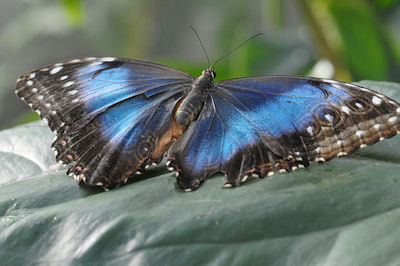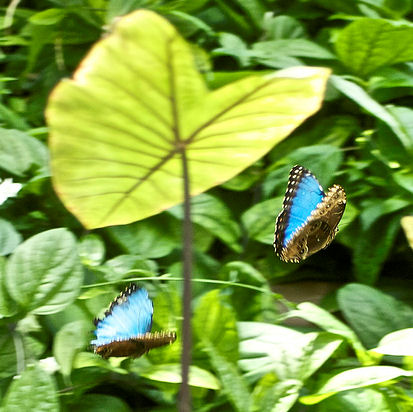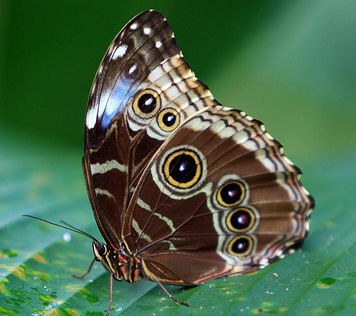Morpho Butterflies
By Irina Bright.
This article is part of our Environment section
See the complete list of all our Articles about Rainforest Animals here.
Morpho butterflies are the true color kings of the rainforests. A dazzling iridescence of their wings + an elegance of flight = a never-ending admiration.
 Morpho Butterfly
Morpho Butterfly© Ferenghi
"Beautiful and graceful, varied and enchanting, small but approachable, butterflies lead you to the sunny side of life. And everyone deserves a little sunshine." ~ Jeffrey Glassberg (Ref. 1)
Native American tribes believed that, born from the caterpillar in the chrysalis, the butterfly was a symbol of rebirth, regeneration and joy. (Ref. 2)
I find morpho butterflies to be among the most fascinating and mesmerizing rainforest animals, as I imagine them fluttering from one flower to another - either eating their food or simply warming up in the sun.
Their bright, gorgeous, iridescent wing colors are irresistible to the eye, and their graceful movements and dances in the air are filled with real magic - that we find ever so heavenly and charming.
These beautiful animals truly lift us "off the ground" and transport us gently into a totally different world of fantasy and daydreams ...
Of course, tropical rainforests - being such a naturally rich and bio-diverse ecosystem - make a great home for morpho butterflies.
The morphos, indeed, form an integral part of the rainforests where they play a big ecological role as flower pollinators.
But their role is not restricted to just that. "Baby" morpho butterflies, i.e. caterpillars, also consume certain rainforest plants and thus regulate plants' growth. On the other hand, caterpillars are, themselves, a source of food for many rainforest insects and birds. (Ref. 3)
The scientific classification places morpho butterflies into the class of: Insecta; order of: Lepidoptera; family of: Nymphalidae; subfamily of: Morphinae; tribe of: Morphini; and genus of: Morpho. (Ref. 4)
There are numerous morpho species that had been identified by various naturalists over the last 200 years.
Some of the better known species are: Morpho peleides (Peleides Blue Morpho, or Common Morpho); Morpho granadensis (Granada Morpho); Morpho menelaus (Menelaus Blue Morpho); Morpho polyphemus (Polyphemus White Morpho); Morpho Rhetenor (Rhetenor Blue Morpho).
Further down in this article, we discuss general points that are common to most Morpho species.
Let us then take a closer look at these colorful neighbors of ours.
What Do Morpho Butterflies Look Like?
Body, Size and Life Cycle
Although most butterfly species are pretty small in size, the morphos are among the largest that we know of.
Their wing-span can reach 20 cm (8 inches), and these butterflies can certainly impress anyone observing them in action.
Morpho butterflies live only for 115 days - this is their complete life cycle from birth (egg) to death.
Colors and Patterns
 © Jean
© Jean
One of the most interesting characteristics about morpho butterflies is certainly the play of colors on their wings.
The topside of the wings of male morpho butterflies is normally blue and purple in color. Female morphos have a paler brown-to-yellow topside coloration, although females of some morpho species may also present lighter blue colors (Ref. 5).
The colors on the male butterflies' wings produce an effect of so-called iridescence.
When a surface is iridescent, it shows shimmering or glowing colors rather than "flat", one-dimensional ones.
While a flat-looking color is usually achieved in nature by means of organic dyes and paints, the morpho iridescence is a result of structural coloration.
Zooming into the morphos' wings reveals a whole matrix of parallel-running ridges, scales and other tiny particles intricately structured and connected to each other. It is exactly these structures which scatter and reflect light in a certain way, and produce iridescent colors.
But such wing structure doesn't only deliver beautiful colors - it also helps morphos to protect their wings from external dirt and dust, which is very important during their short life-cycle.
 © Steve Ryan
© Steve Ryan
The underside of the wings of both morpho males and females contains different shades of brown & yellow and consists of ordinary pigments and dyes.
Probably the most notable feature of the wings' underside is that it is decorated with beautiful "eyespots" - the ornamental spots that look like an eye.
Apart from its obvious aesthetic effects, such spectacular coloration serves as morpho butterflies' defence against potential predators.
Ex., when morphos fly - their topside wings can rapidly change the colors thanks to the change in the angle of the falling light. This, in its turn, creates an effect of a "disappearing butterfly" and makes it hard for predators to track it. (Ref. 6)
Also, when morphos spend time on the forest's floor they keep their wings folded only revealing their undersided brown colors. This works as a camouflage against predators as well.
Where Do They Live? - Geography and Habitats
Morphos are a genus of neotropical ("new tropics") butterflies.
Their habitats and geographical ranges stretch from Mexico straight across Central America, through the Amazon rainforest and down to the Atlantic forests of South America.
The countries that are host to these insects include:
Mexico, Belize, Guatemala, El Salvador, Costa Rica, Panama, Trinidad, Colombia, Venezuela, Brazil, Ecuador, Peru, Suriname, French Guiana, Bolivia, Paraguay, Uruguay, Argentina.
These butterflies normally inhabit tropical rainforests and mountainous regions from the sea-level up to the altitude of around 1,400 meters. (Ref. 7)
They flourish in areas with rich vegetation but suffer from tropical deforestation.
We talk more about morphos' conservation here.
Butterflies may naturally prefer warmer climates as their constitution doesn't allow them to survive successfully in cold temperatures.
Written by: Irina Bright
Original publication date: 2012
Republication date: 2020
References
1. Butterfly Quotes and Sentiments (2012). Retrieved November 12, 2012 from http://www.squidoo.com/butterflyquotes
2. Butterfly Legends (2012). Retrieved November 12, 2012 from http://www.native-american-market.com/butterfly_legends.html
3. Case Study 2. Mistletoe, Mistletoebirds, Butterflies and Ants (2012). Australian Association of for Environmental Education. Retrieved November 12, 2012 from http://www.aaee.org.au/docs/WAbugs/cs2.pdf
4. Morpho. (2012, October 25). In Wikipedia, The Free Encyclopedia. Retrieved November 12, 2012, from http://en.wikipedia.org/w/index.php?title=Morpho&oldid=519724047
5. Ibid.
6. Why are Butterflies Colored? (Interference) (2012). Causes of Color. Why are Things Colored? Retrieved November 12, 2012 from http://www.webexhibits.org/causesofcolor/15A.html
7. Morpho (2012). In Encyclopedia Britannica. Retrieved November 12, 2012 from http://www.britannica.com/EBchecked/topic/392776/morpho